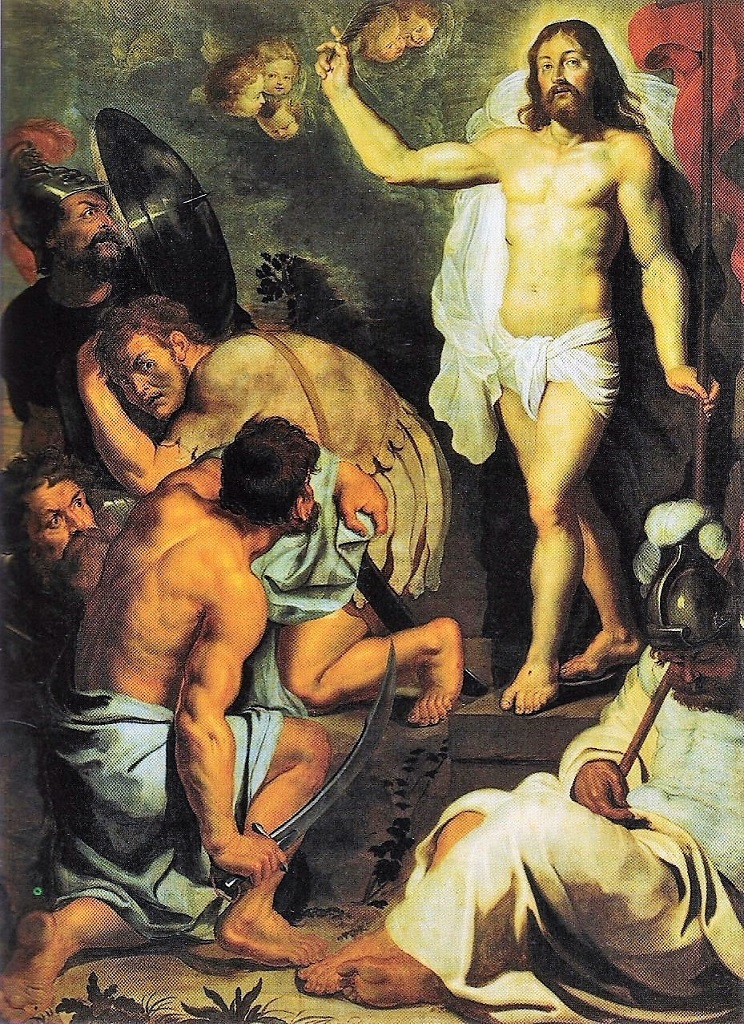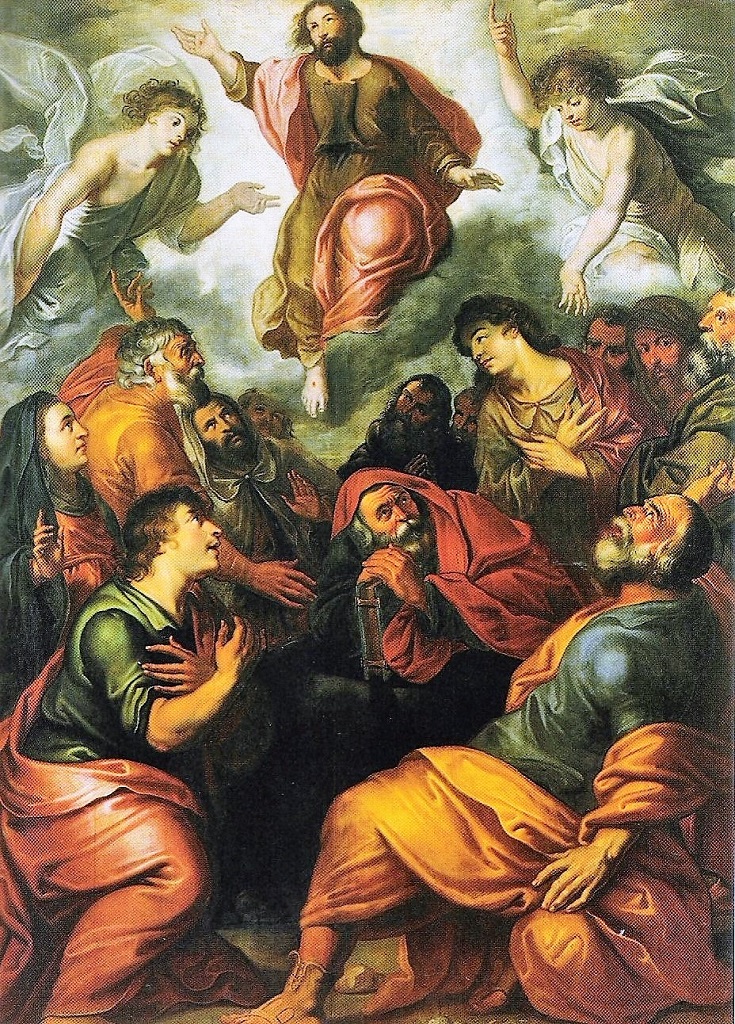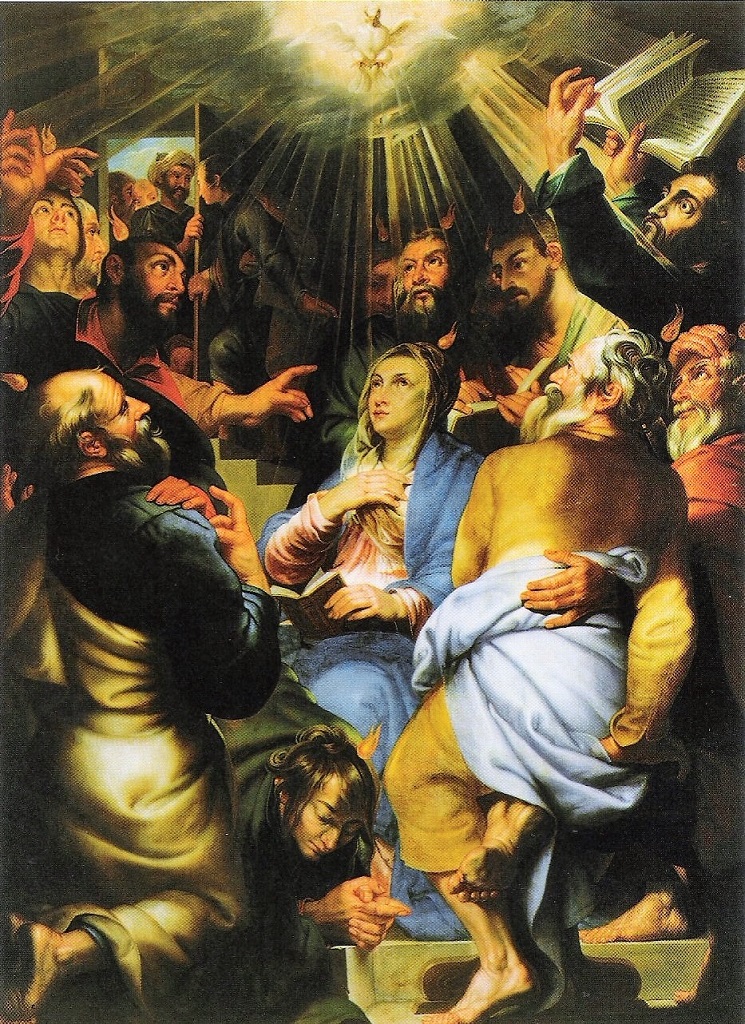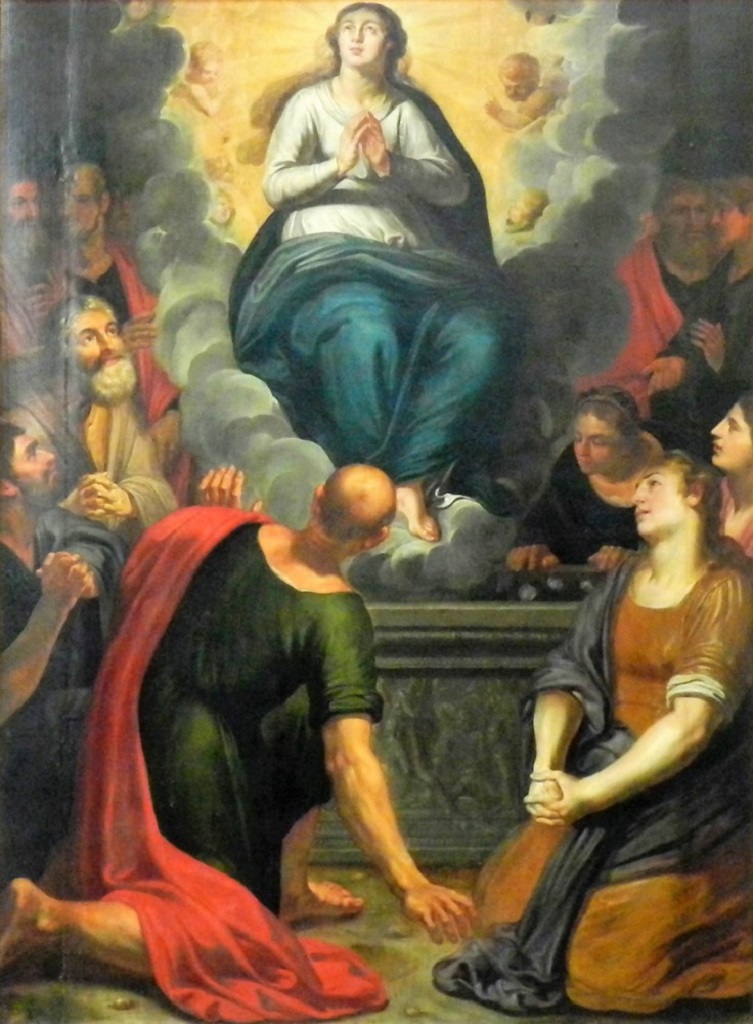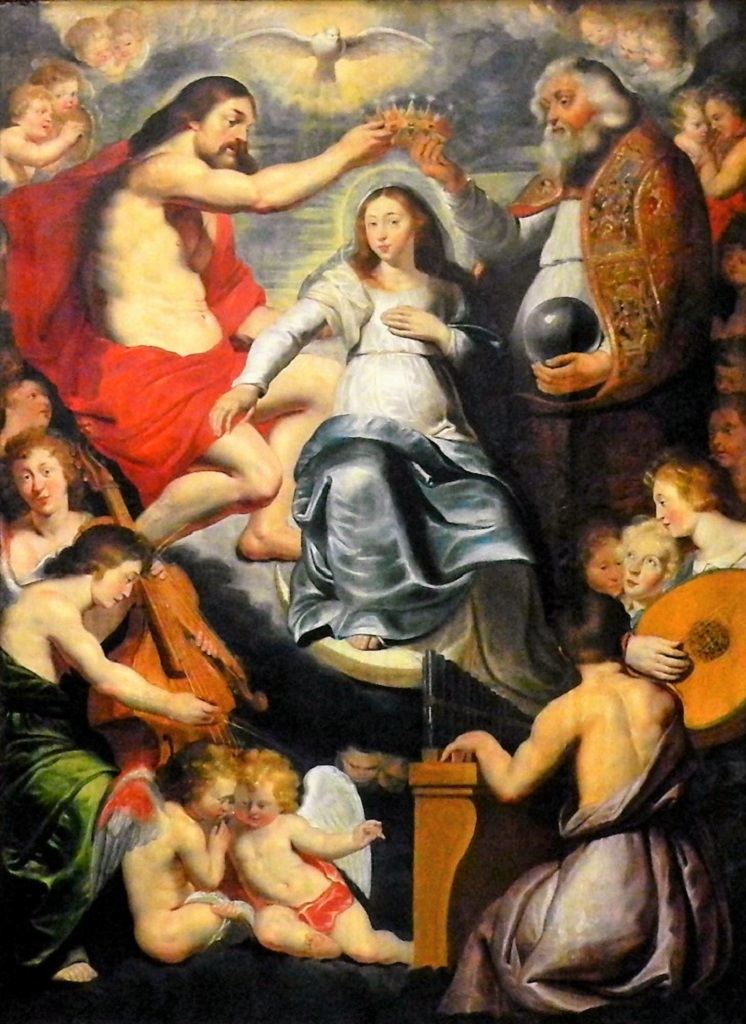Saint Paul’s, the Antwerp Dominican church, a revelation
The cycle of Paintings The Fifteen Mysteries of the Rosary
THE GLORIOUS MYSTERIES
The first Glorious Mystery
THE RESURRECTIONThis is the core of the Christian faith, namely that Jesus rose from the grave on the third day after his death on the cross and lives on. This is celebrated at Easter.
(Aernout Vinckenborgh)
With the fifteenth (and the twelfth?) this is the only painting known with certainty to have been made by Vinckenborgh (° Alkmaar ca. 1590). The day of his death (Antwerp, 1620) is the ‘terminus ante quem’ for these three paintings and maybe for the whole series as well. His parents were buried in the church of the Preachers.
Christ, rosy-cheeked, triumphantly rises from his grave on the third day, holding a red standard and a palm as the signs of victory. From behind His head a golden halo appears as a rising sun. The white loincloth and the shroud intensify the glow of His glorified body. The way the Resurrected One looks straight into the eyes of the spectator is most remarkable!
Soldiers who are on guard to keep Jesus’ disciples from stealing his corpse in order to insinuate a resurrection, are startled and seek protection. Appalled by what is happening one of them tries to hide, another one tries to protect himself from the dazzling light with his right arm. A third one seeks safety behind his shining shield. The fourth, in armour, keeps quiet on the ground. The description “The guards … became like dead men” (Math. 28:4b) can be recognized in the glassy eyes of the first soldier and in the petrified pose of the third. Only the fifth one – in the right corner below – who, in contrast, does not perform his task, remains imperturbably asleep. As he is seated in the foreground he is an outstanding repoussoir figure to accentuate the depth of the composition.
Quite remarkably the soldiers are without shoes. Just notice the dirty soles of the two soldiers in the foreground.
The illumination angle here is not symbolically orientated from Jesus’ glorified body, but head-on, be it slightly from the right. Thus Jesus’ shadow falls from His feet on the oblong tomb stone till the rock behind Him. The simplified postures and the slightly clumsy movements are typical of Vinckenborgh.
The donator was Dominican John Boucket, prior in 1613-1617, and he was possibly the commissioner of the entire cycle.
The second Glorious Mystery
THE ASCENSION
(attributed to Artus Wolffort;
formerly to Aernout Vinckenborgh)
Christ ascends. The cloud that “took Him from their sight” (Acts 1:9) is used cleverly to make Jesus sit on it.
The heavenly light that surrounds Jesus refers to God’s glow or ‘glory’, which Jesus shares from now on. However, this light overshadows the apostles in the background .
Faithful to the Bible (Acts 1:10) Christ is flanked by “two men dressed in white garments”. Their gesticulations illustrate word for word the text in Acts 1:11, from the left to the right. The man on the left points at “this Jesus”; the one on the right, his right hand raised, refers to “who has been taken from you into Heaven”, while his downward left hand suggests the announcement: “will return [to the Earth] in the same way”.
The disciples and Mary “were looking intently at the sky” (Acts 1:10); some of them amazed and in adoration, others totally astonished. Peter and John, whom we recognize by their traditional physiognomy and the colours of their clothes, occupy the most prominent positions in the foreground. By their placement in the corners below they open up the rhombic composition. Quite remarkably both these apostles, contrary to tradition, are wearing sandals.
The third Glorious Mystery
PENTECOSTThe feast, 50 days after Easter, which celebrates the descent of the Holy Spirit. This refers to the story from the Acts of the Apostles in which, after the death of Jesus, the disciples experience how the Holy Spirit shows itself in the form of flaming tongues. As a result, they come out of their seclusion and begin to preach in the languages of their hearers. In fact, this is how the beginning of the Church is celebrated.
(Matthys Voet)
 On the 50th day after EasterThe feast that celebrates the resurrection of Jesus on the 3 day after his death on the cross. This means that Jesus lives on despite his death. This feast is celebrated on the 1 Sunday after the 1 full moon of spring. the miracle occurs in which the apostles, thanks to the inspiration of the Holy Ghost, overcome the fear for the Jews and dare come outside to give testimony to Jesus’ message. The dark space indicates that “the doors were locked (…) for fear of the Jews”. Thanks to the election of Matthias the twelve are complete again.
On the 50th day after EasterThe feast that celebrates the resurrection of Jesus on the 3 day after his death on the cross. This means that Jesus lives on despite his death. This feast is celebrated on the 1 Sunday after the 1 full moon of spring. the miracle occurs in which the apostles, thanks to the inspiration of the Holy Ghost, overcome the fear for the Jews and dare come outside to give testimony to Jesus’ message. The dark space indicates that “the doors were locked (…) for fear of the Jews”. Thanks to the election of Matthias the twelve are complete again.
The apostles (A) are gathered around Mary (M), who has been reading her prayer book. In the composition she is the centre of the rhombic positioning of the apostles, the dove symbolizing the Holy Ghost on top.
From the dove that comes down over them supernatural, clustered beams of light are penetrating the dark residence of the apostles. Mary, the apostles, as well as the hands and faces of almost all the persons present are illuminated. The Holy Ghost (V) is shown as something that “appeared to them (as) tongues of fire, which parted and came to rest on each of them.”
“They were all filled with the Holy SpiritThe active power of God in people. It inspires people to make God present in the world. Jesus was ‘filled with the Holy Spirit’ and thus showed in his speech and actions what God is like. People who allow the Holy Spirit to work in them also speak and act like God and Jesus at those moments. See also ‘Pentecost’.” (Acts 2:3-4a); some new dynamics as a result of which the apostles start to gesticulate fiercely. They receive the gift of speaking in different tongues. The naked foot soles of the apostles are dark, not just because of the shadow play.
In the midst of the spiritual emotion of the apostles Mary (M) remains calm. She humbly looks up to heaven, filled with awe.
A servant (K) on top of the stairs, opens the door. Some “devout Jews from every nation under heaven (…) are gathered in a large crowd” (Acts 2:5-6b). The turban of the first one refers to the exotic of ‘all nations’, that subsequently are mentioned by name (Acts 2:9-11).
The composition was inspired by Rubens’ draft of the illustration in the Breviarum Romanum.
Cornelis Verbeeck paid for this painting.
The fourth Glorious Mystery
MARY’S ASSUMPTION
(Jan Aertsen)
If anyone at all is certain to be in Heaven, it must be the strong woman Mary, whose life was fully focused on God’s will. In this ‘Mystery’ a hopeful perspective is hidden for each believer: whoever seeks God in his life will find Him in Heavenly joy.
Mary is sitting in the centre of a cloud, her hands joined in prayer and her eyes upwards, which indicates her craving for God. Her lower body is still situated in the grey clouds, while her upper body, dressed in white, stands out against the golden background in Heaven.
On the left apostles are looking on; two of them have folded their hands respectfully. Next to the grave there are three women. According to the Legende aurea: Mary Magdalene, and Mary’s two half-sisters: Mary of Clopas and Mary Salome. One of the women is leaning over the empty grave and finds, so the legend goes, some flowers there.
The artist has probably found some inspiration in the painting of the same name by Otto van Veen (München, Alte Pinakothek).
The fifth Glorious Mystery
CORONATION OF THE VIRGIN MARY
(Aernout Vinckenborgh)
Nowhere else in the series Mary assumes the most prominent position, as only now she shares God’s bliss once and for all. As a reward for her “faith until death”, according to Revelation 2:10, she is given “the crown of (eternal) life”. God manifests himself as Holy TrinityThe concept that there is one God who shows himself in threefold form: Father, Son (Jesus of Nazareth) and the Holy Spirit.. God the FatherPriest who is a member of a religious order., the Lord of all life, holds the globe of universe in his hands and is liturgically dressed in a golden embroidered cope. Completely true to the creed, the resurrected Christ, the Son, is “seated at the right hand of the Father”. While He takes his mother by the arm with one hand (and thus ‘assumes’ her), He – together with God the Father – holds the crown above Mary’s head with the other hand.
The dove, symbolic of God’s Holy Spirit, spreads its wings over her.
As in many a song of this feast, the angels rejoice in Mary’s assumption. The 24 of them joyfully make a circle around the central event of Our Lady Mary. It strikes our attention that only the small angels’ heads are winged. Among them there are seven who play a musical instrument: on the left: a timbrel (top corner), a viola and a double base (bottom); and on the right: a recorder (top), a horn, a lute and a positive organ (bottom corner).
Mary here is still presented as a young woman, as the original sin and consequently transitoriness can’t get a hold on her. With the liturgical text “the King is enthralled by your beauty” (Ps 45:11) in mind the painter has succeeded in rendering her as really graceful. She wears a white dress, a shining, light blue satin mantle and a scarf over her long dark blonde hair: the colours of Mary’s Immaculate Conception. This title is also represented by the ensemble of celestial bodies: the sun, moon and the (crown with the) twelve stars, derived from the Woman of the Apocalypse, who is “clothed with the sun, with the moon under her feet, and on her head a crown of twelve stars” (Revelation 12:1). Here Mary subtly wears the sun as an aureole, but in order not to look more distinguished than the Divine Persons, the artist has depicted her aureole disc ‘airily’ light blue, merely suggested by a yellow rim.
Mary’s usual gesture of keeping her hand on her bosom in modest delight, here refers to her rejoicing song Magnificat: “For he has looked upon his handmaid’s lowliness” (Lk. 1:48). Her eye contact with the spectator is most exceptional in a scene like this. It appears as if she looks us straight into the eyes, with a view saying: “My joy can become yours as well. I will be your advocate.”
The donor, the widow Mary Boxhorn, was the mother of Marius Ambrosius Capello, the later prior of the Antwerp Preachers’ ConventComplex of buildings in which members of a religious order live together. They follow the rule of their founder. The oldest monastic orders are the Carthusians, Dominicans, Franciscans, and Augustinians [and their female counterparts]. Note: Benedictines, Premonstratensians, and Cistercians [and their female counterparts] live in abbeys; Jesuits in houses. and BishopPriest in charge of a diocese. See also ‘archbishop’. of Antwerp. The epitaph statue of her and her husband is nearby the main altarThe altar is the central piece of furniture used in the Eucharist. Originally, an altar used to be a sacrificial table. This fits in with the theological view that Jesus sacrificed himself, through his death on the cross, to redeem mankind, as symbolically depicted in the painting “The Adoration of the Lamb” by the Van Eyck brothers. In modern times the altar is often described as “the table of the Lord”. Here the altar refers to the table at which Jesus and his disciples were seated at the institution of the Eucharist during the Last Supper. Just as Jesus and his disciples did then, the priest and the faithful gather around this table with bread and wine..
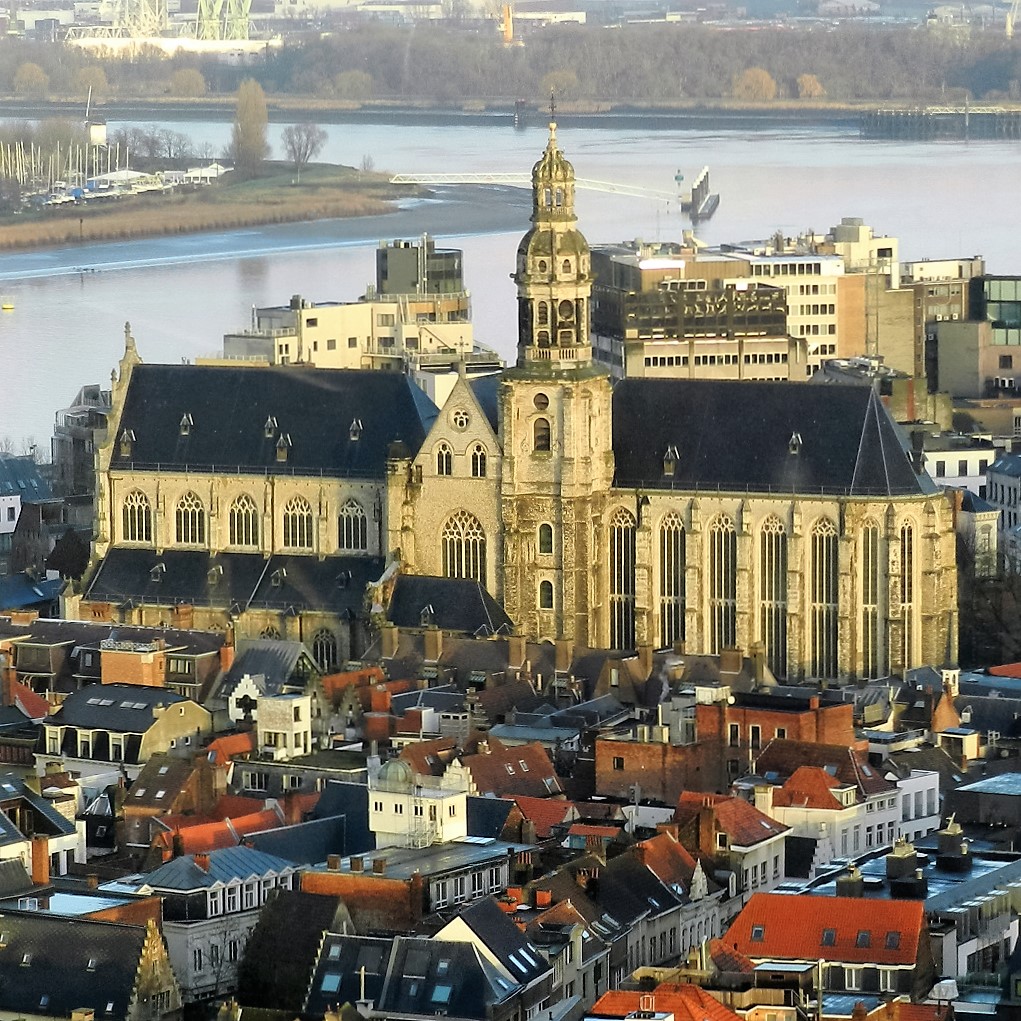
The scientific justification of the data concerning the Mysteries of the Rosary in SaintThis is a title that the Church bestows on a deceased person who has lived a particularly righteous and faithful life. In the Roman Catholic and Orthodox Church, saints may be venerated (not worshipped). Several saints are also martyrs. Paul’s in Antwerp can be found HERE.
It is basically written in Dutch, but using the translate button you can ask for an instant translation in English

